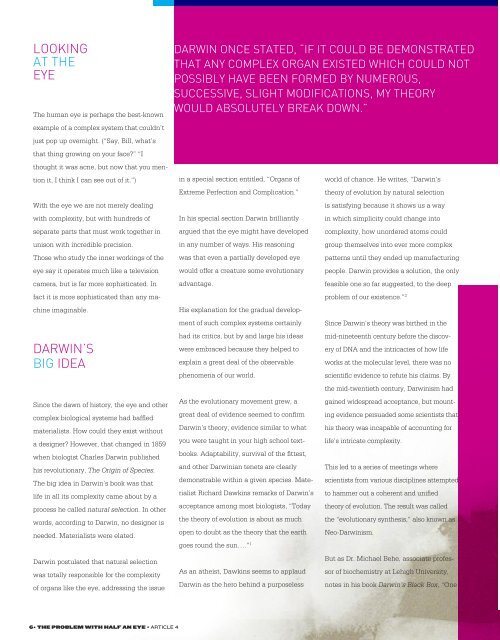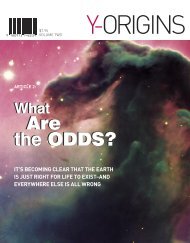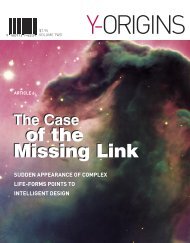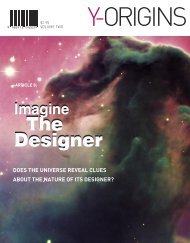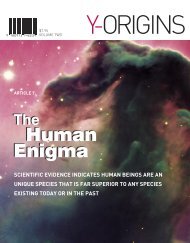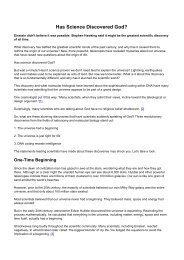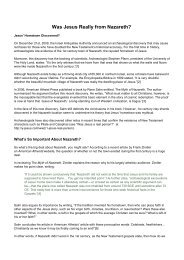half_an_eye4
Create successful ePaper yourself
Turn your PDF publications into a flip-book with our unique Google optimized e-Paper software.
LOOKING<br />
AT THE<br />
EYE<br />
The hum<strong>an</strong> eye is perhaps the best-known<br />
example of a complex system that couldn’t<br />
just pop up overnight. (“Say, Bill, what’s<br />
that thing growing on your face?” “I<br />
thought it was acne, but now that you mention<br />
it, I think I c<strong>an</strong> see out of it.”)<br />
With the eye we are not merely dealing<br />
with complexity, but with hundreds of<br />
separate parts that must work together in<br />
unison with incredible precision.<br />
Those who study the inner workings of the<br />
eye say it operates much like a television<br />
camera, but is far more sophisticated. In<br />
fact it is more sophisticated th<strong>an</strong> <strong>an</strong>y machine<br />
imaginable.<br />
DARWIN’S<br />
BIG IDEA<br />
Since the dawn of history, the eye <strong>an</strong>d other<br />
complex biological systems had baffled<br />
materialists. How could they exist without<br />
a designer? However, that ch<strong>an</strong>ged in 1859<br />
when biologist Charles Darwin published<br />
his revolutionary, The Origin of Species.<br />
The big idea in Darwin’s book was that<br />
life in all its complexity came about by a<br />
process he called natural selection. In other<br />
words, according to Darwin, no designer is<br />
needed. Materialists were elated.<br />
Darwin postulated that natural selection<br />
was totally responsible for the complexity<br />
of org<strong>an</strong>s like the eye, addressing the issue<br />
DARWIN ONCE STATED, “IF IT COULD BE DEMONSTRATED<br />
THAT ANY COMPLEX ORGAN EXISTED WHICH COULD NOT<br />
POSSIBLY HAVE BEEN FORMED BY NUMEROUS,<br />
SUCCESSIVE, SLIGHT MODIFICATIONS, MY THEORY<br />
WOULD ABSOLUTELY BREAK DOWN.”<br />
in a special section entitled, “Org<strong>an</strong>s of<br />
Extreme Perfection <strong>an</strong>d Complication.”<br />
In his special section Darwin brilli<strong>an</strong>tly<br />
argued that the eye might have developed<br />
in <strong>an</strong>y number of ways. His reasoning<br />
was that even a partially developed eye<br />
would offer a creature some evolutionary<br />
adv<strong>an</strong>tage.<br />
His expl<strong>an</strong>ation for the gradual development<br />
of such complex systems certainly<br />
had its critics, but by <strong>an</strong>d large his ideas<br />
were embraced because they helped to<br />
explain a great deal of the observable<br />
phenomena of our world.<br />
As the evolutionary movement grew, a<br />
great deal of evidence seemed to confirm<br />
Darwin’s theory, evidence similar to what<br />
you were taught in your high school textbooks.<br />
Adaptability, survival of the fittest,<br />
<strong>an</strong>d other Darwini<strong>an</strong> tenets are clearly<br />
demonstrable within a given species. Materialist<br />
Richard Dawkins remarks of Darwin’s<br />
accept<strong>an</strong>ce among most biologists, “Today<br />
the theory of evolution is about as much<br />
open to doubt as the theory that the earth<br />
goes round the sun….” 1<br />
As <strong>an</strong> atheist, Dawkins seems to applaud<br />
Darwin as the hero behind a purposeless<br />
world of ch<strong>an</strong>ce. He writes, “Darwin’s<br />
theory of evolution by natural selection<br />
is satisfying because it shows us a way<br />
in which simplicity could ch<strong>an</strong>ge into<br />
complexity, how unordered atoms could<br />
group themselves into ever more complex<br />
patterns until they ended up m<strong>an</strong>ufacturing<br />
people. Darwin provides a solution, the only<br />
feasible one so far suggested, to the deep<br />
problem of our existence.” 2<br />
Since Darwin’s theory was birthed in the<br />
mid-nineteenth century before the discovery<br />
of DNA <strong>an</strong>d the intricacies of how life<br />
works at the molecular level, there was no<br />
scientific evidence to refute his claims. By<br />
the mid-twentieth century, Darwinism had<br />
gained widespread accept<strong>an</strong>ce, but mounting<br />
evidence persuaded some scientists that<br />
his theory was incapable of accounting for<br />
life’s intricate complexity.<br />
This led to a series of meetings where<br />
scientists from various disciplines attempted<br />
to hammer out a coherent <strong>an</strong>d unified<br />
theory of evolution. The result was called<br />
the “evolutionary synthesis,” also known as<br />
Neo-Darwinism.<br />
But as Dr. Michael Behe, associate professor<br />
of biochemistry at Lehigh University,<br />
notes in his book Darwin’s Black Box, “One<br />
6• THE PROBLEM WITH HALF AN EYE • ARTICLE 4


